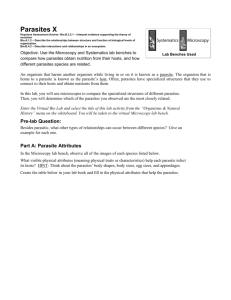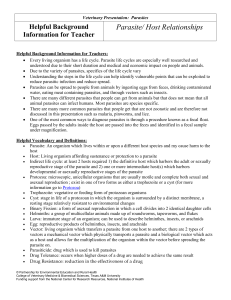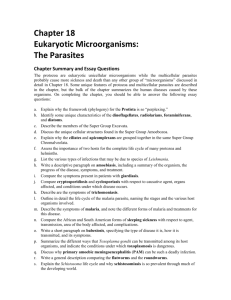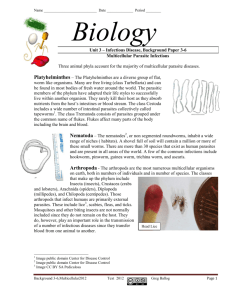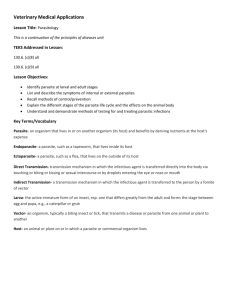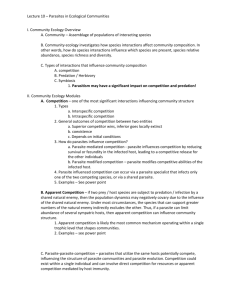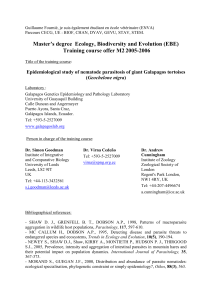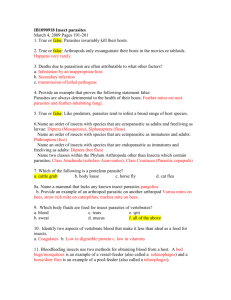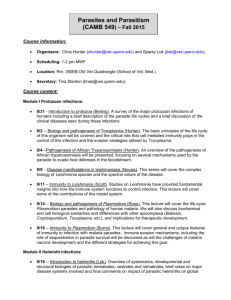shabtay05
advertisement
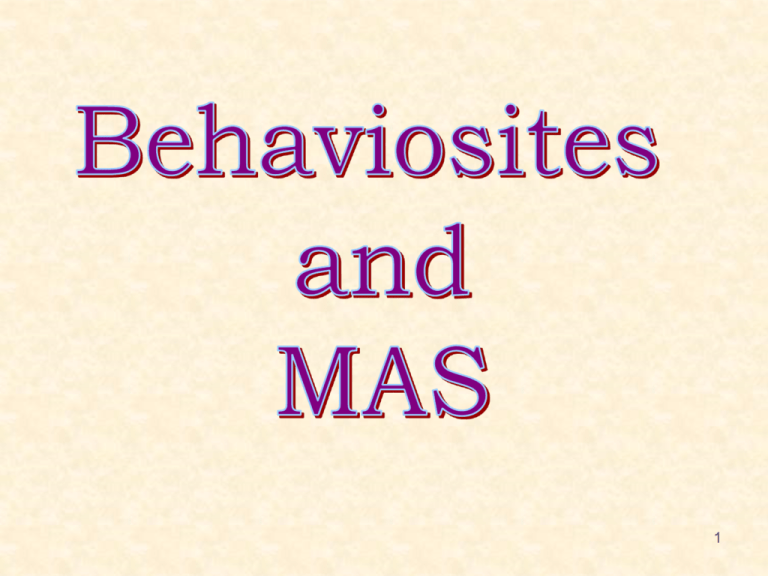
1 Parasites- Motivation • In the past, nature was something to conquer. In recent years, scientist have been looking at nature as something that can be learned from. • The ability to take working concepts from nature and apply them to human made technology is very appealing. 2 Parasites- Motivation • Parasites are specialized in entering a (specific) host and exploiting it’s resources. • Some parasites actually alter the behavior of the host (behaviosites) to some other typical behavior- which is not always destructive to the host. • Harnessing this paradigm to MAS by using behaviosites that will change the behavior of a system can turn out to be very powerful, due to the special qualities of the parasite. 3 Lecture Layout 1. 2. Define biological parasite and see examples. Parasites in computer science (briefly): • As helpers in genetic algorithms using co-evolution. • As malware in the electronic world. 3. Desired traits of behaviosites and use example. 4. Future work. Scanning EM of 4 African Trypanosomes Nature 414 ( (2001) Parasite In Nature • A parasite is an organism that lives inside or outside the living tissue of a host organism at the expense of it. • The biological interaction between the host and the parasite is called parasitism. The parasite usually harms the host, but not necessarily. • It can have a complex life cycle. 5 African Trypanosomes Human 1% flies infected Tsetse 40,000/bite need 300-500 Fly Reservoir Host 6 Piekarski, 1962 Behaviosites in Nature • Parasite changing host behavior in ants: In the case of Dicrocoelium, the behavior of ants is modified so that they crawl up grass stalks to improve their chances of being ingested "accidentally" by a cow and thus transmitting the parasite. • The venom of the wasp Ampulex compressa, leaves its victim, a cockroach, incapable of spontaneous movement, but not paralyzed. It will walk when led by the wasp. The wasp guides the cockroach back to the wasp’s nest, where it is sealed up with it’s eggs. 7 Categories of Host Manipulation • Change in activity (up or down): reduction in speed/distance traveled or increased activity, exploration. Vectors can be affected: fly less (mosquitoes with filaria) or bite more, or change host preferences • Conspicuous behavior: Height-seeking behavior, photophilia (light-seeking), changes in color (loss of camouflage) , changes in size • Changes in social behavior: castration, changes in mating behavior (host or parasite or compensation?), changes in dominance. 8 Neuromodulators • Neuromodulators can resculpt neural circuits, giving an animal the behavioral flexibility it needs to survive in a complex changing world. • This provides parasites with a potential mechanism for manipulating host behavior. • Can be applied in neural networks for example. 9 Keen Selection in Hosts • In genetically homogenous system, host keen selection can evolve: In host suicide the host behaves in such a way as to increase the probability of death by predation in order to lower the risk of parasite infection for other members of the host species. • This is apparent in bees, ants etc. • Host suicide in cells is called apoptosis. 10 Cost of Manipulation • The value of host manipulation, and the level of manipulation, depends on costs and benefits to the parasite (of course). • The main costs are the costs of producing host hormones. • Sometimes there is also the cost of not reproducing. This May lead to parasite keen selection: Dicrocoelium dendriticum is an example of a CNS parasite where one "manipulator" benefits all the other parasites in the host. 11 Host Helping Behaviosites • Sticklebacks (Gasterosteus aculeatus) parasitized with a cestode larvae foraged more actively, recovered faster from a frightening stimulus, and, if deprived of food, suppressed their fright response sooner than uninfected fish. • Bumblebees, Bombus spp., appear to have successfully mastered the use of altered behavior for their own advantage. Parasitized worker stayed in the field overnight instead of returning to the nest. They spent significantly more time in cold areas than did non-parasitized workers. (The cold retarded parasitoid development ) • Can also be found in humans’ parasites. 12 Parasites in Computer Science • Parasites appear in two forms in CS: – As helpers in genetic algorithms using co-evolution. • Tierra Virtual World (Thomas Ray 1992) • Co-evolving parasites improving the sorting problem (Hillis WD. 1990 and many more examples) – As malware in the electronic world. • Parasite is a known concept: Computer viruses, Worms, Trojan Horses as parasites (R.J Bagnall). • Viruses today are more focused and interested in quietly stealing our data and control over the computer than just crashing it (Meet the Sonic Worm, Zone Alarm 2000) 13 The Matrix example 14 Automatic Story Generation • The ability to generate narrative is important for entertainment, (army) training or education. • Virtual world games have a very big market and byproducts (character selling in E-Bay). (Eladharu, Lindley, 04) • Two main interests lie in the automatic creation of a story – Believable characters – Plot coherence (reidl, Young, 04) 15 Automatic Story Generation • There are several spectrums in which automatic story generation can be described: (Oz project, CMU) – Scripted Story – Only NPC – “Drama Manager” Generation of Novel Story Only Human users Endogenic Story Creation 16 Automatic Story Generation • Behaviosites can enter into an existing virtual world, and make some (surprising?) behavioral changes by “infecting” the characters. • The behaviosite should be endogenic in the story, and not “a force from above”. Allows flexibility. • This way, for example, a parasitisized hero can do evil deeds, and face the consequences. 17 Automatic Story Generation • Example for character behavior Schema: (Ross wants to ask Rachel on a date) (Cavazza, Charles, Mead, 01) 18 Desired Traits of Behaviosites I • The most important feature of the behaviosite is that it knows the system very well. • The behaviosite must not crash or degrade the system, otherwise, it is a normal computer parasite. • It need not infect everything in the system, otherwise it should have been a feature of the system. • Infection by behaviosite can be apparent or hidden. (Baboon example) 19 Desired Traits of Behaviosites II • Behaviosites apply a special kind of symbiosis – Behaviosites alter the behavior of the host – The environment benefit is considered, not the host • Behaviosites can have some cost for the behavior manipulation. • Finding the host can be an issue. • Behaviosites may communicate with each other, thus forming some kind of network between hosts. • Distributed systems are a good place to finding rich environments for behaviosite activity. 20 Future Steps • Mathematically define the concept of “Behaviosite” and it’s desired traits. • Define what is a behavior of a system, in order to change it (multi-agent, distributed systems). • Find more environments and case studies in which this paradigm is helpful. 21

